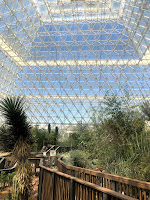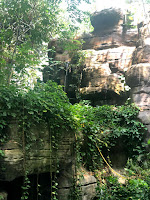Sunday (28) - Another hot day at 90°F by mid-afternoon. The two A/C units did a passable job. There is still a lot of heat that gets into the RV as the insulation isn't that great. And without a lot of wind, I could have the awning out to shade the refrigerator. It's been doing good with freezer temperatures around 3°F if I don't have the ice maker running. The additional load of making ice will raise the temperature by about 10°F.
Monday (29) - Today, we visited the Biosphere 2 site being operated by the University of Arizona. It is located about twenty miles north of Tucson. The purpose of the experiment was to replicate the biological processes on earth and see if humans can survive. They grew all their own food and had no physical supplies except what they brought in with them when the experiment started.This is the residential complex and the dome on top is the library. Apparently, it wasn't used much due to the long spiral staircase but from the pictures, the 360° view was pretty good. The glass pyramid structures are the different areas such as desert, rainforest, ocean, etc. They are full of vegetation all nicely labeled with the species and what part of the planet they were from.I remember hearing of this project and got the impression that it was only a partial success. The other side of this experiment was the human side. Could a small group of people survive in a confined area while raising all their food, recycling all water, and not hate everyone. These types of studies will be essential if people ever hope to be a multi-planetary species.
Not seen in my pictures are two domes listed as "lungs". These adjust the air pressure inside of the dome to match the ambient air pressure. Otherwise, the glass walls would blow out. Since the system is closed, the air needed to be collected and re-injected since no "new" air was permitted. At least initially. Additional oxygen was added when they couldn't figure out why the levels were dropping. It turned out to be a micro-organism population consuming the oxygen.
I would recommend visiting the Biosphere 2 facility if you find yourself in Oracle, AZ. This is one of those places that I've wanted to visit for a number of years. I wasn't disappointed.








Thanks for sharing this, Richard. Although I would not want to live in a confined bubble should the surface be no longer sustaining life as we know it today, I find this to be a very interesting experiment. Does it function completely self-sustaining by green energy (wind, solar)?
ReplyDeleteNo. In fact there was a large team of people outside monitoring, maintaining power, climate, etc. inside of the biosphere. The focus was on food, air, water, and interactions. Power was externally supplied via solar, diesel, and natural gas generators. The cooling system used a lot of power.
DeleteThanks for the info, Richard.
DeleteThanks from me too Richard. I followed the early days of the experiment - Popular Mechanics if I remember correctly! Thanks for the update.
ReplyDeleteI remember hearing a lot about the experiment. Mostly negative. It was great to see it.
DeleteSo these are the sights I missed by not paying the entry fee....thanks
ReplyDeleteIt was pretty interesting. Though a little pricy.
DeleteVery cool visit, thanks for sharing!
ReplyDeleteI wanted to visit last year but I found out about it too late.
Delete